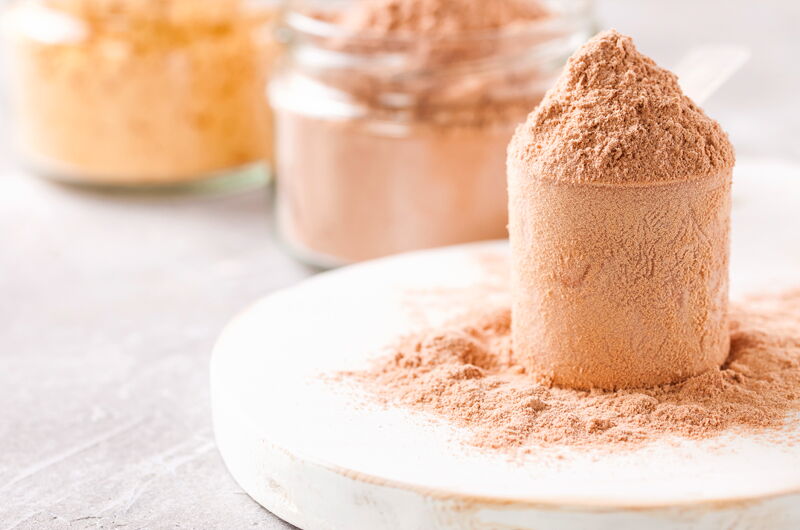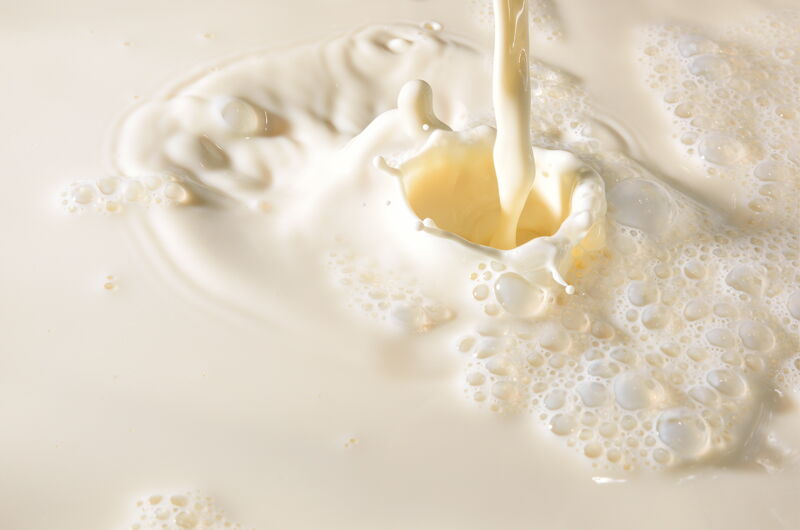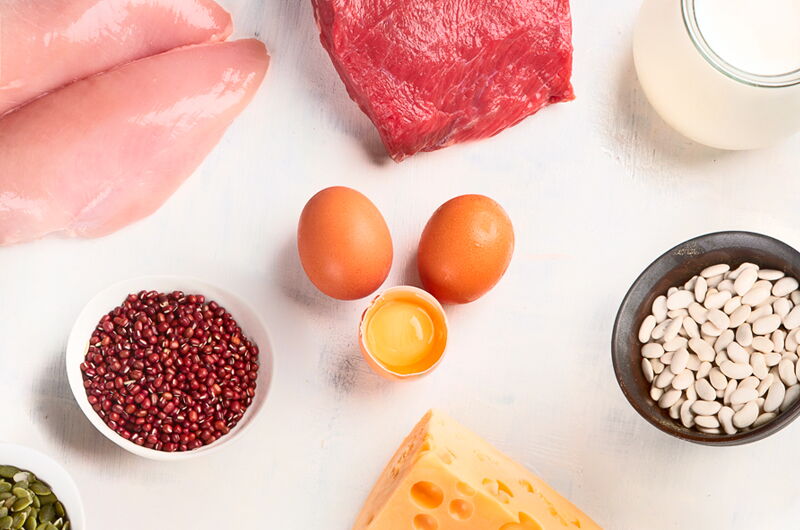The universe of protein powder supplements is truly vast and presents an infinite choice regarding the source of the raw material (milk, meat, eggs, fish, soy and other vegetable sources), the quality, the process to which it is subjected, the presence of additives designed to improve digestibility, palatability or sometimes to mask defects or cunning in the quality/price ratio.

The typical question of those who are preparing to buy a protein powder is almost always: 'which are the best?', And, honestly, a dry and absolute answer (isolated whey, hydrolyzed etc..) is always wrong, because, instead , the most correct and simple answer is that, once the good quality of the product has been ascertained, the best ones are those that best suit your needs. Having said that, then how to ascertain the quality and how to choose the best ones for a specific need requires a proper in-depth study, and we enter into a subject that is sometimes controversial and complicated, but we try to establish the simple bases that can guide yourselves independently or insiders who advise you (coaches, shopkeepers, etc ...) towards a suitable choice.
Meanwhile, the need to create powdered protein supplements, which is nothing more than the extraction of the protein fraction from any natural and edible food, in the sports field responds to some main needs:
- isolation of the protein portion only from all the others (carbohydrates, fats) that may be present in the whole food.
- practicality of replacing the protein base of a meal with something practical and quick to consume.
- integration of a protein quota that cannot be reached with normal nutrition (an example can be protein in vegetable powders in the case of vegan / vegetarian diets).
- purely technical reasons such as the speed of assimilation; for example in the post workout a faster assimilable protein is indicated and some powdered Protein, in particular the hydrolyzed versions are those that enter the bloodstream in the shortest possible time after ingestion.
In this regard, I anticipate that the purpose of this article is not to delve deeply into technical-scientific questions of this kind (which has already been done and which will still be dealt with in other articles), but to give a rational and practical orientation to the consumer. of the wide range of protein powders found on the market.
Milk's Protein
When we talk about Protein obtained from cow's milk, a first distinction consists in those obtained from whey (known as whey ) and Protein obtained from casein.
In fact, the protein fraction of milk, in this cow's case, includes two different classes of Protein:
- Casein (80% of total Protein)
casein -α (50%)
casein -Β (30%)
casein -k (15%)
(there is also a γ casein (5%), which actually represents only a portion, called C -terminal, of B-casein) - Whey protein (20% of total protein)
Β-lactoglobulin (breast synthesis)
α-lactalbumin (breast synthesis)
other Protein (largely filtered without modification from the blood, including serum albumin, lactoferrin,, immunoglobulins, proteolytic enzymes, oligopeptides)

There are notable differences between caseins and whey Protein both in the response to thermal or enzymatic treatments and in the amino acid composition. The caseins are not very sensitive to heat treatments, therefore they do not suffer significant losses during the pasteurization or sterilization of milk, instead they coagulate by acidification or by the action of proteolytic enzymes. On the contrary, the whey Protein do not coagulate either by the effect of enzymes or by acidification; instead they coagulate by the action of heat and can therefore be denatured during the heat treatments of pasteurization and sterilization (limited loss through the use of the right temperatures and the right heat exposure times).
From an amino acid point of view, although caseins still have a high content of amino acids and (being Protein of animal origin) a high biological value, this is however lower than that of whey Protein, which are richer in essential amino acids.
Whey whey protein
When we talk about Whey supplements , therefore, these contain whey Protein that can be extracted in real ways, the first distinction is made between Whey isolate and Whey concentrate.
Concentrated Whey Protein are obtained through micro and ultrafiltration processes, which use physical filters to separate fat and lactose from the protein, without damaging it (the differences between the two are minimal and depend on the size of the filtration pores, about a micrometer large in the microfiltration. and 4 times lower in ultrafiltration). In this way, a powder richer in fats, lactose and minerals is obtained, with a lower protein content (70-85%). Per this reason they are less expensive than isolated whey Protein, where the protein content is on average between 89 and 94%.
The isolated Whey are obtained by ion exchange or by cross-flow microfiltration.
Ion exchange is the technique that allows to obtain isolated Whey Protein with the highest protein concentration (> 90%), but poor in some important components, such as lactoferrins, immunoglobulins and glycomacropeptides, which are lost or denatured during the production phases (the ion exchange process separates Protein on the basis of their electric charge, through the use of some chemical substances). The process that offers the best compromise between protein content and loss of precious protein components is offered by cross-flow microfiltration, which allows to reach protein levels close to 90% while preserving important components such as lactoferrins and macropeptides.
To the question therefore: 'among the whey are the isolated ones better?' The answer is not absolutely yes. If you want a powder that contains a very high content of Protein and very few carbohydrates and fats (for example if you are in the cutting phase or in any case on a very restricted diet of carbohydrates and fats) or if you want to limit the intake of lactose as much as possible because you are intolerant (attention is minimal but never zero in any whey protein) then the answer is yes; if you are still in a bulking or intermediate phase, or a beginner who is still building muscle mass and does not have too many problems related to lactose then concentrate is definitely the ideal choice, less expensive, tastier and richer than naturally present bioactive peptides in whey.
Hydrolyzed whey Protein deserve a separate mention, they are obtained by enzymatic hydrolysis, a process that allows to preserve some important components that would be inactivated by other techniques that use acids or heat, and to improve their taste compared to the latter processes. The result is a protein powder made up of free amino acids and di-tripeptides (chains of only 2 or three amino acids) that are able to cross the intestinal mucosa even faster than the free amino acids themselves. They are essentially a sort of pre-digested protein, in which the digestion work normally carried out by the gastric enzymes in our stomach has already been done, resulting in a very digestible protein that theoretically enters the bloodstream with a speed greater than any other whey.
A study [Energy, O., Hallihan, A. & Jakeman, Human insulinotropic response to oral ingestion of native and hydrolysed whey protein] which compared some metabolic effects of whey protein isolate with whey protein hydrolysates proved that the gastric emptying rate is almost identical, while the insulin peak following the ingestion of the two whey is later, but also more intense and prolonged, after the ingestion of the hydrolyzed whey Protein compared to isolated whey. This makes hydrolyzed Whey a very technical protein, particularly suitable for post-workout, and which, among other things, may contain bitter notes in the taste due to the presence of some free amino acids, therefore highly recommended for elite athletes.
Protein obtained from milk casein
Unlike whey, which are digested and transported into the bloodstream in a fairly short time, casein is by definition the slow-absorbing protein. This is due to its characteristic ability to form a gel in the stomach, which at the same time incorporates and retains some important nutrients (for example mineral salts including calcium and phosphorus, but also lactose) and is able to provide a slow release and sustained of amino acids in the bloodstream, which can last for several hours. Therefore, while whey Protein promote greater protein synthesis, caseins are better able to provide a prolonged supply of amino acids over time and limit protein catabolism especially when fasting for prolonged periods (eg overnight). From the point of view of the amino acid profile, as already mentioned, while whey is globally richer in essential amino acids, casein is richer in BCAAs and glutamine.
Casein is extracted from milk by ultrafiltration, without the use of chemicals, preserving the presence of bioactive milk peptides that support immune function and promote muscle growth. There are essentially 3 types of casein:
- Micellar casein: it is native casein in its natural form, obtained only through physical processes of micro and ultrafiltration, which preserve all its natural characteristics.
- Calcium caseinate: obtained by going through various acid precipitation processes and adding calcium to casein, which produces a protein with a higher protein percentage, greater water solubility, less fat, less lactose and less sodium than casein micellar, with an improvement in digestibility but on the other hand a partial protein denaturation induced by chemical treatments. It is also the cheapest of the 3 types.
- Hydrolyzed casein: casein subjected to the hydrolysis process, which makes a protein with rapid assimilation and with very interesting characteristics and in part superimposable to the hydrolyzed whey, but, while the amino acid spike of the hydrolyzed caseins in the blood stream is superimposable to that of hydrolyzed whey, the maintenance of the blood aminoacidemia is even more prolonged over time. It is still a very technical protein ideal in the post workout.
Hydrolyzed salmon Protein
It is a truly unique protein, originally created to meet the special needs of astronauts and which has since found application in the medical and sports fields.

The best raw material is produced by a Norwegian company that uses a specific proprietary enzymatic process that extracts amino acids, small peptides and micronutrients from the basic material (exclusively Atlantic salmon).
The result is a hydrolyzate containing an amino acid pattern very close to the composition of skeletal muscle and consisting of amino acids in free form (60%) and small peptides (40%) which do not exceed the molecular weight of 560 Dalton, which are therefore able to cross the gastrointestinal tract without any digestion and enter the bloodstream as quickly as a protein source can do, while keeping the bioactive peptides unaltered (i.e. small chains of amino acids that have particular functions within the body already in the form in which they are, including for example Anserine, Lysina-Proline and Isoleucine / Leucine-Proline) and preserving the integrity of a large number of vitamins and minerals. Compared to hydrolysates of whey and casein, therefore, the hydrolyzate of salmon seems to be even faster assimilable, has an even better amino acid spectrum, with a probable higher nitrogen retention rate, greater bioavailability and a greater presence of bioactive peptides and trace elements. It is, again, naturally lactose-free, therefore, among the hydrolysates, it is certainly the choice for those suffering from severe lactose intolerance.
Protein from other protein sources (vegetables, eggs, meat)
Protein powders can still be extracted from plant, egg and meat sources. They are decidedly less popular and less used than the previous ones, especially in the sports field, but they certainly have unique and interesting characteristics.

Those of vegetable origin are normally extracted from soy, pea, brown rice, hemp sativa, and with the same concept explained above they can be in isolated or concentrated form.
Their limit is represented by the fact that they reflect the biological value and the amino acid profile of the raw material and therefore like all vegetable protein sources, they can individually be deficient in some essential amino acids. However, they are an excellent support in vegan / vegetarian regimes (with an eye perhaps to complete the amino acid profile by mixing Protein from different sources or in any case through the range of protein foods available for these regimes) or, together with a good pool of essential amino acids, when for example, the bodybuilder athlete wants to carry out so-called 'detox' periods in which he tries to limit the production of nitrogenous waste and the kidney load as much as possible.
Egg Protein are obtained from egg white, which has a biological value of 100 and a high protein content. They are therefore an excellent alternative to whey isolate, naturally lactose-free and with an absorption rate intermediate between that of whey and that of casein.
Finally, meat protein powders are normally obtained by hydrolysis of beef, have a high biological value and are naturally lactose-free and rich in BCAAs, glutamine and creatine. Be careful not to be misled by the term hydrolysis, hydrolysis is simply a process that extracts 'smaller fractions' from the whole protein, it is then the degree of hydrolysis and the technique that may or may not produce free amino acids and di-tripeptides of the whey or hydrolyzed casein or the salmon protein mentioned above, it is not the same concept in this case.
How to evaluate quality and value for money
Perhaps the most controversial topic of all because beyond any technical discussion about the opportunity, effectiveness, timing and optimization of using a protein powder, you certainly want to be sure that you are buying what you are actually thinking of buying and paying a fair price for it. The elements you have available to ensure this are:
- Label :
- Don't be seduced by names and slogansbut go and read the data of the label, a name or a slogan of 100% protein for example, go and see 100% of what. The protein content can never be, there are various factors (natural moisture content, carbohydrates and fats even if minimal and other ingredients or elements) that keep this rate below 90-95% even in the purest protein. Furthermore, precisely due to factors such as the humidity of the dust there is by law a tolerance of 15% on the protein content, which means that the crafty manufacturer could legally declare a 15% more. So, in fact, do not be fascinated by very high protein levels and trust more than those you see on average declared by the most accredited producers on the market for that kind of protein. The quality of the Protein depends on the
- Raw material: the protein source must be clear, if certified by the companies producing the raw material better, even if even here some cleverness can be hidden, such as the declaration of a certified material, of logos allowed or not, when then this material constitutes only a small portion of the powder used and the rest is made up of less valuable raw material. If the price of this product is much lower than others that claim the same raw material at 100% you are entitled to have suspicions. Another more gross deception is seeing a protein, for example, advertised as an isolated Whey (more expensive) and then reading on the label it is found in a mix with other Protein; it is not the wrong mix per se, as previously said it can better meet your needs in terms of quality / price / palatability,
- Ingredients: some ingredients such as flavors, vitamins, salt and various additives are not necessarily a deception, sometimes they are necessary and desired to improve the properties of the protein, other times they are definitely excessive. An ingredient list that is too long or with the least valuable ingredients written first on the list should make you wonder what you are buying. Among the ingredients that should make you suspect a low quality of the product are palm oil, maltodextrin, carrageenan and amino acids in free form (the latter falsely increase the protein percentage of the product, altering its amino acid profile and introducing non-essential and inexpensive amino acids, such as glycine).
- Market Price:
- as already mentioned, the market price is a very important parameter and by now the supply of protein powders is vast and the market is globalized, which definitely crushes the price variability. With the same type of protein, a too low base price almost certainly masks a low quality (whether of the raw material, amino acids or other added ingredients, etc.) and a too high price in the same way can be an indication of poor purchasing Energy. of the manufacturing company (probably because it has very small productions) which is then reflected in the price to the public,
